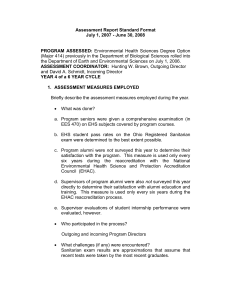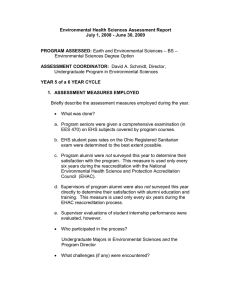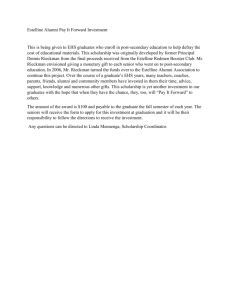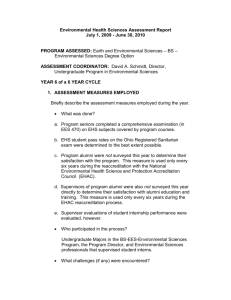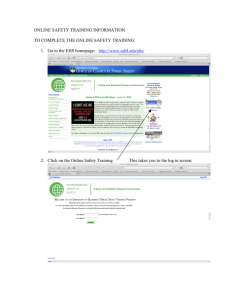Environmental Health Sciences
advertisement
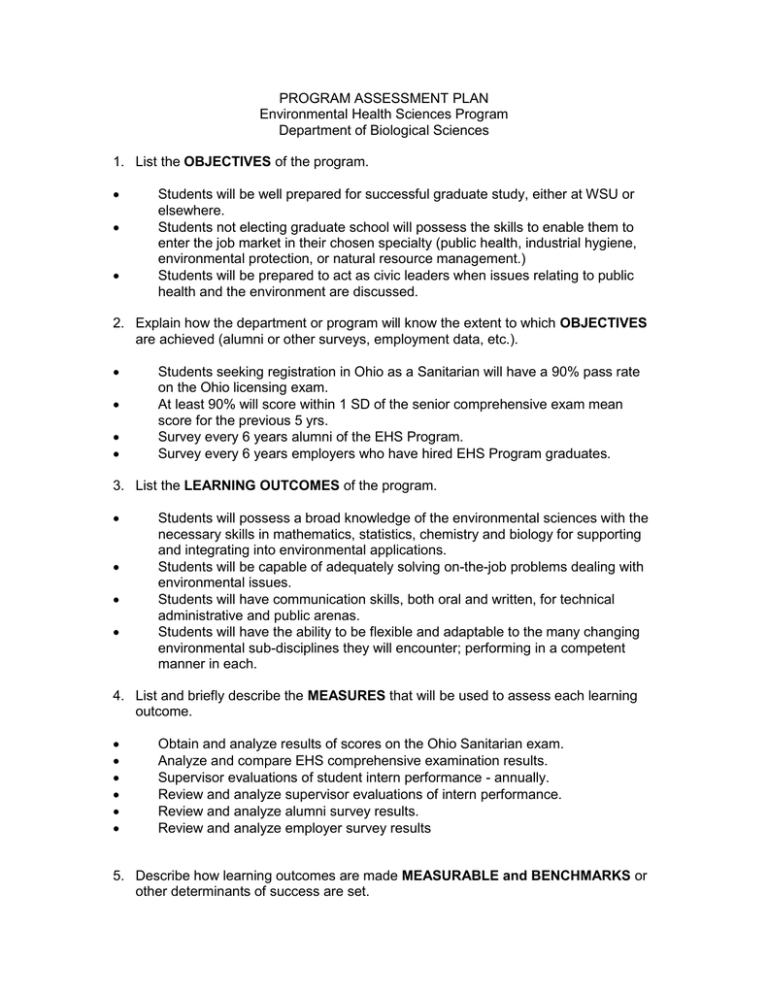
PROGRAM ASSESSMENT PLAN Environmental Health Sciences Program Department of Biological Sciences 1. List the OBJECTIVES of the program. Students will be well prepared for successful graduate study, either at WSU or elsewhere. Students not electing graduate school will possess the skills to enable them to enter the job market in their chosen specialty (public health, industrial hygiene, environmental protection, or natural resource management.) Students will be prepared to act as civic leaders when issues relating to public health and the environment are discussed. 2. Explain how the department or program will know the extent to which OBJECTIVES are achieved (alumni or other surveys, employment data, etc.). Students seeking registration in Ohio as a Sanitarian will have a 90% pass rate on the Ohio licensing exam. At least 90% will score within 1 SD of the senior comprehensive exam mean score for the previous 5 yrs. Survey every 6 years alumni of the EHS Program. Survey every 6 years employers who have hired EHS Program graduates. 3. List the LEARNING OUTCOMES of the program. Students will possess a broad knowledge of the environmental sciences with the necessary skills in mathematics, statistics, chemistry and biology for supporting and integrating into environmental applications. Students will be capable of adequately solving on-the-job problems dealing with environmental issues. Students will have communication skills, both oral and written, for technical administrative and public arenas. Students will have the ability to be flexible and adaptable to the many changing environmental sub-disciplines they will encounter; performing in a competent manner in each. 4. List and briefly describe the MEASURES that will be used to assess each learning outcome. Obtain and analyze results of scores on the Ohio Sanitarian exam. Analyze and compare EHS comprehensive examination results. Supervisor evaluations of student intern performance - annually. Review and analyze supervisor evaluations of intern performance. Review and analyze alumni survey results. Review and analyze employer survey results 5. Describe how learning outcomes are made MEASURABLE and BENCHMARKS or other determinants of success are set. Measures are quantifiable and can therefore be tallied, summarized, and analyzed. See above and below. Benchmarks are set by the EHS Program Director to ensure successful program reaccreditation every 6 years by the National Environmental Health Science and Protection Accreditation Council. New benchmarks are set following reaccreditation through a review of any changes in accreditation guidelines and any recommendations made by the Accreditation Council. 6. Describe the process by which FINDINGS will be derived from the measures as detailed under the next heading. Data from each of the measures will be gathered and analyzed by the EHS Assessment Committee according to the schedule set forth in Section 8. 7. Describe the process by which findings are analyzed to determine what IMPROVEMENTS should be made to better meet objectives and learning outcomes. The EHS Assessment Committee and instructors of EH courses will bi-annually review the extent to which learning outcomes are met and recommend any actions necessary to remedy any deficiencies Assessment committee review ongoing surveys and programs of study. Departmental Undergraduate Curriculum review and approve new and modified courses and programs. 8. Identify a TIMETABLE for assessment components The EHS Assessment Committee will review the following assessment components: Senior Exiting Surveys – annually Grade Distributions – annually Alumni Surveys – every 6 years (Year 1, Year 7) Intern Supervisor Evaluations - annually Statistical Data from certifying and assessment exams – annually Employer Survey – every 6 years (Year 1, Year 7) A synthesis assessment report will be prepared every 6 years (beginning Year 7) 9. Briefly explain how the program’s assessment plan supports and interacts with ACCREDITATION and LICENSURE requirements (if applicable). Many of the assessment criteria used here are also used in support of 6-year cycle reaccreditation by the National Environmental Health and Protection Accreditation Council. 10. Describe how the objectives and learning outcomes of the program are COMMUNICATED to students and others. Welcome letter Post on departmental website Alumni Mailing List As part of a new lower level course called “Careers in Biological Sciences, Exercise Biology, Environmental Science, and Clinical Laboratory Sciences.”
